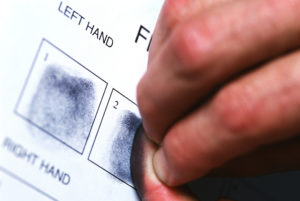
Why Are Fingerprints So Commonly Used as Evidence?
It seems as though every police drama you watch includes law enforcement officers looking for fingerprints at the scene of the crime. Part of this is simply because it makes for good television; however, in reality fingerprint evidence can be very useful in a criminal case. There are two reasons why fingerprint evidence is so commonly used. First, fingerprints are relatively easy to locate and compare. Fingerprints can be lifted off of a wide variety of surfaces and these days it is common to require fingerprints for many reasons – even opening a bank account requires you to submit a fingerprint. The other reason fingerprint evidence is often useful is that the odds of two people having identical fingerprints are astronomical. Therefore, if the police find a match, it is compelling evidence that the individual was at least at the scene of the crime relatively recently.
Types of Fingerprint Evidence
There are three basic types of fingerprint evidence that the police may encounter, including:
- Plastics – prints that are three dimensional, such as a print left on a wax or butter.
- Patent – visible prints that are left, typically when the suspect’s finger gets liquid on it and then transfers that liquid print onto another surface. For example, the suspect might get blood on his/her hands and then touch a surface. The blood will transfer a fingerprint onto the surface.
- Latent – invisible prints left when the body’s natural oils transfer a print onto a surface. Sweat on a suspect’s hands, for example, could cause the suspect to leave a latent print on a surface he/she touched.
How Are Fingerprints Identified and “Lifted?”
Of course, Hollywood makes finding and collecting, or “lifting,” fingerprints look extremely easy. In reality, some types of fingerprints are fairly easy to locate and lift while others are more challenging. The manner in which fingerprints are located and collected depends on the type of fingerprint left behind and the surface on which the print is left.
For example, collecting plastic and patent prints is fairly easy. Plastic prints are easy to see with the naked eye. Once located, a small imprint can be made or they can be photographed. Patent prints can also be photographed using a high resolution camera. The image is then blown up sufficiently to identify the unique markings within the fingerprint and compared to existing prints in one of several different data bases.
It is usually more difficult both to locate and to lift latent prints. Traditionally, these prints were collected by dusting with a specialized powder to check for prints. If there is a print on the surface, the powder will adhere to the oil from the fingerprint, essentially highlighting the print which can then be photographed just like patent prints. The print is then “lifted” using old-fashioned clear tape and placed on a card for preservation.
While old-fashioned dusting is still used, there are also some newer methods for collecting latent fingerprints that allow the police to collect prints that once could not be lifted. Some of these newer methods include:
- Alternate light source (ALS) — laser or LED devices that emit a particular wavelength, or spectrum, of light. For example, investigators may use a blue light with an orange filter to find latent prints on desks, chairs, computer equipment or other objects at the scene of a break-in.
- Cyanoacrylate — “superglue” processing, or fuming, of a surface before applying powders or dye stains. The vapors (fumes) will adhere to any prints present on the object allowing them to be viewed with oblique ambient light or a white light source.
- Chemical developers – typically used for porous surfaces such as paper. The chemicals react with specific components of latent print residue, such as amino acids and inorganic salts. Ninhydrin, for example, causes prints to turn a purple color, which makes them easily photographed.
Contact Us
If you have been charged with a criminal offense in the State of Tennessee, it is in your best interest to consult with an experienced Smyrna criminal defense attorney at Bennett, Michael & Hornsby. Contact the team today by calling 615-898-1560 to schedule your appointment.
- Understanding the Role and Responsibilities of a Trustee - April 23, 2024
- When Are Miranda Warnings Required? - April 16, 2024
- 5 Benefits of Mediation in a Tennessee Divorce - April 9, 2024






